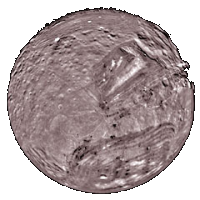Our Solar System has some pockmarked, weird and contorted moons. Let's have a lok at a few of them.
First up: Miranda, Uranus’s largest moon.
 Miranda has some very distinct features that have left astronomers wondering why it’s so ugly. As well as the usual craters and pockmarks that cover any rocky object with basically no atmosphere, Miranda has deep, almost parallel gashes running along its southern hemisphere. It looks a bit like a ball of yarn. These deep grooves are confined to three regions in the Southern hemisphere.
Miranda has some very distinct features that have left astronomers wondering why it’s so ugly. As well as the usual craters and pockmarks that cover any rocky object with basically no atmosphere, Miranda has deep, almost parallel gashes running along its southern hemisphere. It looks a bit like a ball of yarn. These deep grooves are confined to three regions in the Southern hemisphere.
Astronomers have a couple of ideas about where these features come from... [Read more about Three of the Strangest Moons in our Solar System]
- Log in to post comments

 Just to reminder that we shall be hosting a star party event for visiting pupils from Ayresome Primary School & Lego Innovation Studio up at the Whitby Youth Hostel on April 12th. Elizabeth Labelle; assistant Head Teacher was impressed with the pupil response and feedback after last year’s inaugural event, and has contacted the society with regards to host another one this year. The start time is around 20:30h at the WHA on the east cliff.
Just to reminder that we shall be hosting a star party event for visiting pupils from Ayresome Primary School & Lego Innovation Studio up at the Whitby Youth Hostel on April 12th. Elizabeth Labelle; assistant Head Teacher was impressed with the pupil response and feedback after last year’s inaugural event, and has contacted the society with regards to host another one this year. The start time is around 20:30h at the WHA on the east cliff.  I don’t believe it! The Eskdale ‘Star night’ (Wednesday 22nd) unfortunately coincided with the only bad weather night of the week so our planned outdoor observations were quite out of the question. No scopes then, but with a new looking inflatable planetarium brought over and manned by York University boffins, who needed clear skies. All we needed was somewhere to use for the scale solar sytem(s). An ideal location was at hand – the main school corridor, which at nearly 60 mtrs long was tailormade for our demo...
I don’t believe it! The Eskdale ‘Star night’ (Wednesday 22nd) unfortunately coincided with the only bad weather night of the week so our planned outdoor observations were quite out of the question. No scopes then, but with a new looking inflatable planetarium brought over and manned by York University boffins, who needed clear skies. All we needed was somewhere to use for the scale solar sytem(s). An ideal location was at hand – the main school corridor, which at nearly 60 mtrs long was tailormade for our demo... 
 It's going to be a busy late-March and into April.
It's going to be a busy late-March and into April.  The first of the events (a last minute unscheduled event on the 18th) was predominantly clouded out. Mark and Keith therefore enrolled the scouts in helping to demonstrate the scale solar system.
The first of the events (a last minute unscheduled event on the 18th) was predominantly clouded out. Mark and Keith therefore enrolled the scouts in helping to demonstrate the scale solar system.  The date of the Vernal Equinox and officially the start spring in the northern hemisphere falls on March 20th this year. This is when the Sun's path - the ecliptic - first crosses the celestial equator on its apparent journey northwards into the sky...
The date of the Vernal Equinox and officially the start spring in the northern hemisphere falls on March 20th this year. This is when the Sun's path - the ecliptic - first crosses the celestial equator on its apparent journey northwards into the sky...